
10686
.pdf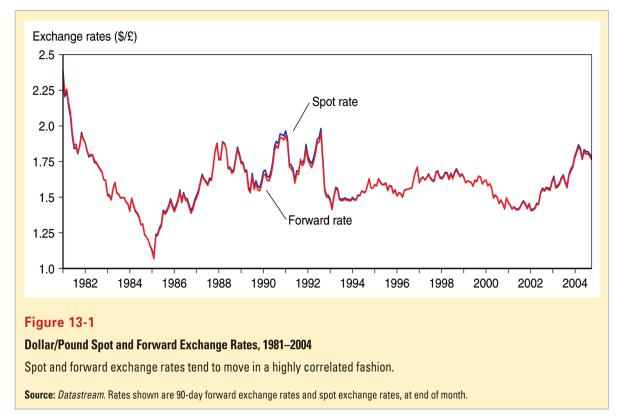
forward dates are typically 30, 90, 180 or 360 days in the future.
rates are negotiated between individual institutions in the present, but the exchange occurs in the future.
Spot and Forward Rates
Other methods of currency exchange
•Foreign exchange swaps: a combination of a spot sale with a forward repurchase, both negotiated between individual institutions.
swaps often result in lower fees or transactions costs because they combine two transactions.
•Futures contracts: a contract designed by a third party for a standard amount of foreign currency delivered/received on a standard date.
contracts can be bought and sold in markets, and only the current owner is obliged to fulfill the contract.
Other Methods of Currency Exchange
•Options contracts: a contract designed by a third party for a standard amount of foreign currency delivered/received on or before a standard date.
contracts can be bought and sold in markets.
a contract gives the owner the option, but not obligation, of buying or selling currency if the need arises.
The Demand for Currency Deposits
•What influences the demand for (willingness to buy) deposits denominated in domestic or foreign currency?
•Factors that influence the return on assets determine the demand for those assets.
•Rate of return: the percentage change in value that an asset offers during a time period.
•The annual return for $100 savings account with an interest rate of 2% is $100 x 1.02 = $102, so that the rate of return = ($102 - $100)/$100 = 2%
•Real rate of return: inflation-adjusted rate of return.
•stated in terms of real purchasing power: the amount of real goods & services that can be purchased with the asset.
•the real rate of return for the above savings account when inflation is 1.5%: 2% – 1.5% = 0.5%. The asset can purchase 0.5% more goods and services after 1 year.
•If prices are given at some level, inflation is 0% and (nominal) rates of return = real rates of return.
•For bank deposits in different currencies, we often assume that prices are given at some level. (A good short run assumption.)
•Risk of holding assets also influences decisions about whether to buy them.
•Liquidity of an asset, or ease of using the asset to buy goods and services, also influences the willingness to buy assets.
•But we assume that risk and liquidity of bank deposits in the foreign exchange market are the same, regardless of their currency denomination.
•risk and liquidity are only of secondary importance when deciding to buy or sell currency.
•importers and exporters may be concerned about risk and liquidity, but they make up a small fraction of the market.
•We assume that investors are primarily concerned about the rates of return on bank deposits. Rates of return are determined by
•interest rates that the assets earn
•expectations about appreciation or depreciation
•A currency’s interest rate is the amount of a currency an individual can earn by lending a unit of the currency for a year.
•The rate of return for a deposit in domestic currency is the interest rate that the bank deposit earns.
•To compare the rate of return on a deposit in domestic currency with one in foreign currency, consider
•the interest rate for the foreign currency deposit
•the expected rate of appreciation or depreciation of the foreign currency relative to the domestic currency.
•Suppose the interest rate on a dollar deposit is 2%.
•Suppose the interest rate on a euro deposit is 4%.
•Does a euro deposit yield a higher expected rate of return?
•Suppose today the exchange rate is $1/€1, and the expected rate 1 year in the future is $0.97/€1.
•$100 can be exchanged today for €100.
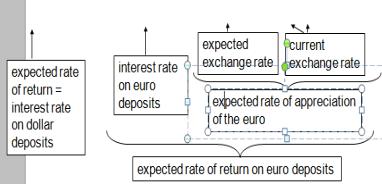
•These €100 will yield €104 after 1 year.
•These €104 are expected to be worth $0.97/€1 x €104 = $100.88.
•The rate of return in terms of dollars from investing in euro deposits is ($100.88-$100)/$100 = 0.88%.
•Let’s compare this rate of return with the rate of return from a dollar deposit.
•rate of return is simply the interest rate
•After 1 year the $100 is expected to yield $102: ($102-$100)/$100 = 2%
•The euro deposit has a lower expected rate of return: all investors will prefer dollar deposits and none are willing to hold euro deposits.
•Note that the expected rate of appreciation of the euro is ($0.97- $1)/$1 = -0.03 = -3%.
•We simplify the analysis by saying that the dollar rate of return on euro deposits approximately equals
•the interest rate on euro deposits
•plus the expected rate of appreciation on euro deposits
•4% + -3% = 1% ≈ 0.88%
•R€ + (Ee$/€ - E$/€)/E$/€
•The difference in the rate of return on dollar deposits and euro deposits is
•R$ - (R€ + (Ee$/€ - E$/€)/E$/€ ) =
R$ |
R€ |
- (Ee$/€ - E$/€)/E$/€ |
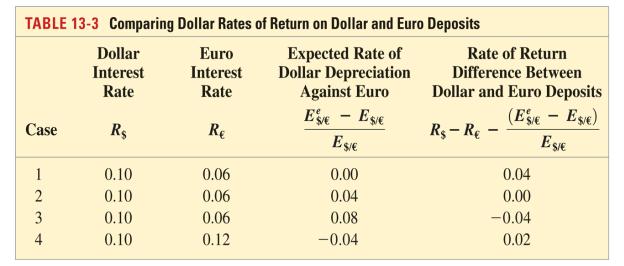
The Demand for Currency Assets
The Market for Foreign Exchange
•We use the
demand for (rate of return on) dollar denominated deposits
and the demand for (rate of return on) foreign currency denominated deposits to construct a model of the foreign exchange market.
•The foreign exchange market is in equilibrium when deposits of all currencies offer the same expected rate of return: interest parity.
interest parity implies that deposits in all currencies are deemed equally desirable assets.
•Interest parity says:
R$ = R€ + (Ee$/€ - E$/€)/E$/€
•Why should this condition hold? Suppose it didn’t.
Suppose R$ > R€ + (Ee$/€ - E$/€)/E$/€ .
Then no investor would want to hold euro deposits, driving down the demand and price of euros.
Then all investors would want to hold dollar deposits, driving up the demand and price of dollars.

The dollar would appreciate and the euro would depreciate, increasing the right side until equality was achieved.
•How do changes in the current exchange rate affect expected returns in foreign currency?
•Depreciation of the domestic currency today lowers the expected return on deposits in foreign currency.
A current depreciation of domestic currency will raise the initial cost of investing in foreign currency, thereby lowering the expected return in foreign currency.
•Appreciation of the domestic currency today raises the expected return of deposits in foreign currency.
A current appreciation of the domestic currency will lower the initial cost of investing in foreign currency, thereby raising the expected return in foreign currency.
Expected Returns on Euro Deposits when Ee$/€ = $1.05 Per Euro
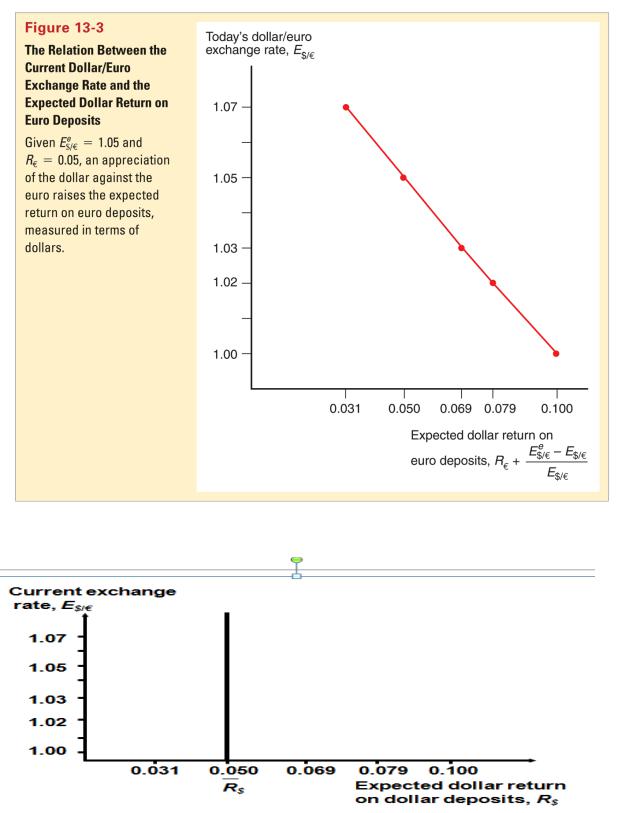
The Current Exchange Rate and the Expected Return on Dollar Deposits
The Current Exchange Rate and the Expected Return on Dollar Deposits
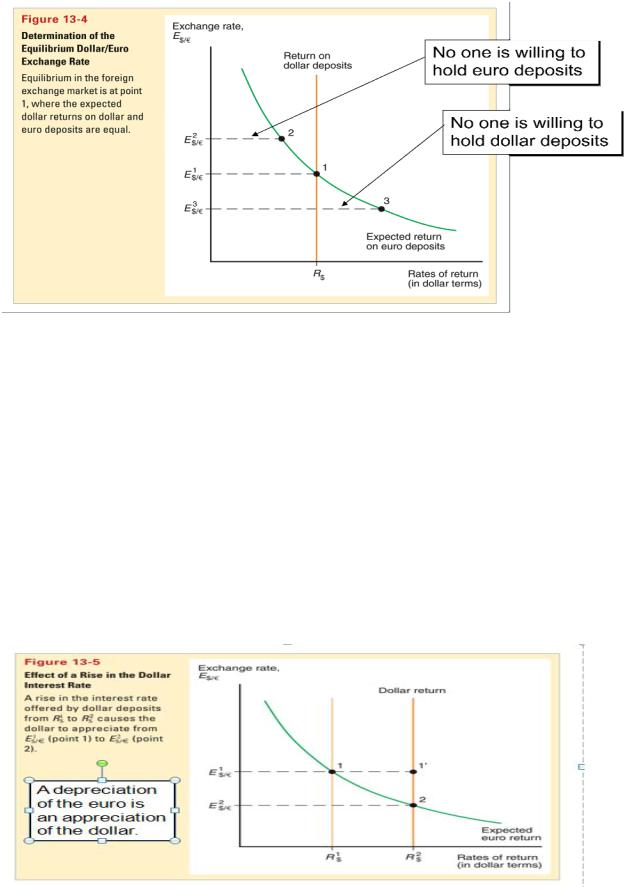
Determination of the Equilibrium Exchange Rate
The Market for Foreign Exchange
•The effects of changing interest rates:
an increase in the interest rate paid on deposits denominated in a particular currency will increase the rate of return on those deposits.
This leads to an appreciation of the currency.
A rise in dollar interest rates causes the dollar to appreciate.
A rise in euro interest rates causes the dollar to depreciate.
The Effect of a Rise in the Dollar Interest Rate
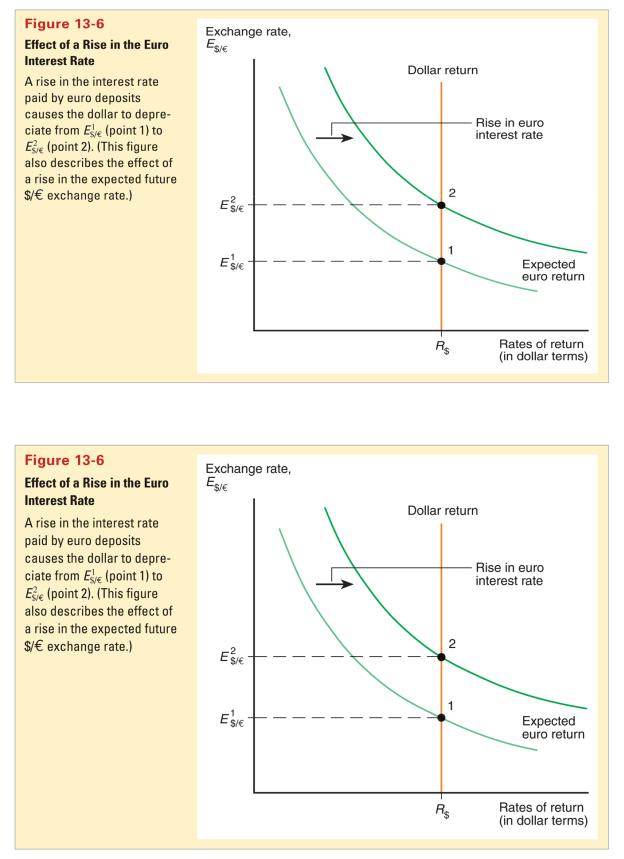
The Effect of a Rise in the Euro Interest Rate
The Effect of an Expected Appreciation of the Euro
•If people expect the euro to appreciate in the future, then investment will pay off in a valuable (“strong”) euro, so that these future euros will be able to buy many dollars and many dollar denominated goods.
the expected return on euros therefore increases.
an expected appreciation of a currency leads to an actual appreciation (a self-fulfilling prophecy)
an expected depreciation of a currency leads to an actual depreciation (a self-fulfilling prophecy)
Covered Interest Parity
•Covered interest parity relates interest rates across countries and the rate of change between forward exchange rates and the spot exchange rate:
R$ = R€ + (F$/€ - E$/€)/E$/€
where F$/€ is the forward exchange rate.
•It says that rates of return on dollar deposits and “covered” foreign currency deposits are the same.
How could you make easy, risk-free money in the foreign exchange markets if covered interest parity did not hold?
Covered positions using the forward rate involve little risk.
Summary
1.Exchange rates are prices of foreign currencies in terms of domestic currencies, or vice versa.
2.Depreciation of a country’s currency means that it is less expensive (valuable) and goods denominated in it are less expensive: exports are cheaper and imports more expensive.
A depreciation will hurt consumers of imports but help producers of exports.
